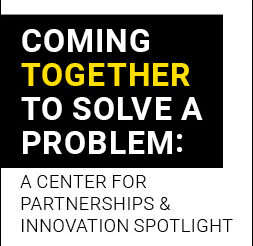Coming Together to Solve a Problem: A Center for Partnerships & Innovation Spotlight – Flagger Force

Aging infrastructure spans our nation and utilities. In addition to day-to-day needs, this inevitable decay stays top of mind for many in the industry. How do companies address present and future challenges? How do they better plan now for what’s to come with current resources available? How will their solutions impact prospective generations? Many companies look to industry organizations for assistance and guidance in solving these types of issues.
With large initiatives, such as infrastructure maintenance, it’s sometimes best to get others on board in finding an answer. And what better ship than a partnership to lead the way in the deep, sometimes murky, waters of problem solving. When industry-related entities come together around a common goal, it allows for thought-sharing, solution-oriented thinking. This is one of the best ways to achieve innovative solutions.
Collaborative Problem-Solving on a National Level
The National Association of Regulatory Utility Commissioners (NARUC) is an advocacy and education organization that helps to facilitate information exchange for those in the utility industry. Founded in 1889, the non-profit organization began with a focus on representing the railroad industry and later evolved to include the state public service commissions who regulate public utilities (energy, telecommunications, power, water, and transportation). Understanding the need for collaborative problem-solving among various groups in a single place, NARUC provided that platform in 2000, which over time, evolved into the Center for Partnerships and Innovation (CPI) in 2017 to identify challenges facing state commissions and provide organizations with the expertise and strategies to assist in their complex decision-making.
The CPI operates as a fully grant- funded program, with most of the funding coming from the U.S. Department of Energy, the U.S. Department of Commerce’s National Institute of Standards and Technology, and various charitable sources. The focus of CPI is to build relationships, develop resources, and deliver training that provides answers to state commissioners’ questions across a range of energy and utility areas (see the chart below).
CPI Brings the Right People Together
Since its implementation, the CPI has found a lot of success in the development of task forces within its organization that bring together public utilities, commissioners, government officials, and state energy offices to learn and collaborate. The need for task forces was identified by NARUC members, and each group works on finding a solution to a specific problem.
One task force that was developed through CPI is focused on comprehensive electricity planning. This group includes members of NARUC and the National Association of State Energy Officials (NASEO). They operate with the mission for developing state-led pathways for a more resilient, efficient, and affordable grid. Members of the group include representatives from the Colorado Public Utilities Commission, the Utah Office of Energy Development, the Public Utilities Commission of Ohio, and the California Energy Commission.
With new technology available for consumers, this group reviews what states are doing, both at federal and local levels, to drive the use of new energy resources, such as solar,
energy efficiency, demand management, and microgrids. The group was recently formed and plans to organize a series of in-person working meetings to further develop research and implementation practices around new technology.
“The NARUC and NASEO partnership task force on comprehensive electricity planning will help members that are navigating uncharted territory,” says Nick Wagner, board member of the Iowa Utilities Board and former NARUC president. “We hope to provide a set of tools to help the integration of new technologies in the power system in harmony with individual state policy frameworks while continuing to provide customers safe, reliable, and affordable energy.”
Partnering Across Borders
Being able to partner with organizations that cross state lines allows for greater insight into a shared problem and leads to better, more sustainable solutions. Some CPI task forces,
including the NARUC and NASEO partnership mentioned earlier, span borders such as this, making in-person meetings more challenging. Many of these groups meet during virtual events, which are coordinated by CPI.
“By introducing virtual meetings, multiple states from the nation can come together to accelerate learning from similar programs and initiatives, share lessons learned, and emulate each other for innovation,” says Danielle Byrnett, director at CPI. “We continue to work to meet our members where they are and support growing initiatives throughout the United States.”
Bridging the gap in nationwide information sharing, the CPI publishes various resources surrounding innovative insights available for all, including the public, to download at any time. These resources were put together based on task force efforts through CPI committees of various stakeholders coming together to share their knowledge with the industry from their respective organizations.
CPI is just one example of how bringing the right minds together around a common goal can have great impact on our nation’s infrastructure. As the industry looks to the future of utility maintenance, partnerships seem like a no brainer in helping to find solutions.
Some publications that CPI has produced are “Electric Vehicles: Key Trends, Issues, and Considerations for State Regulators” and “Natural Gas Distribution Infrastructure Replacement and Modernization: A Review of State Programs.” You can find these and other resources by CPI at NARUC.org/CPI.
